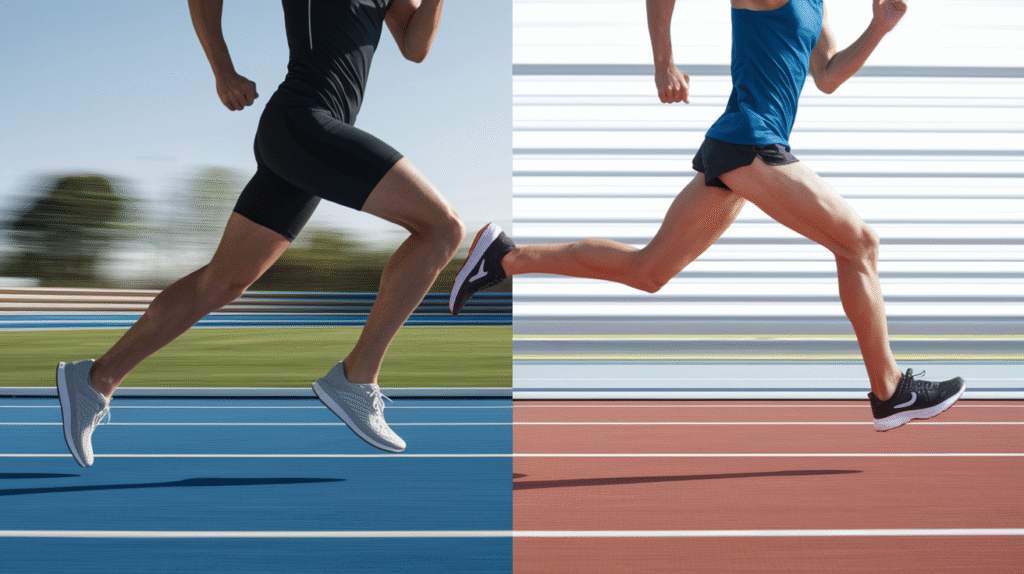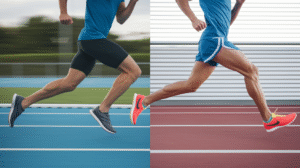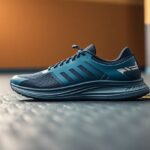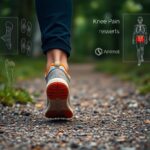
You may be curious about how your choice of footwear impacts your running economy. This informative analysis explores into the contrasting effects of barefoot shoes and their cushioned counterparts on your performance, efficiency, and overall running experience. Discover how each option affects your biomechanics, injury risk, and energy expenditure, enabling you to make informed decisions that align with your personal running goals. Whether you’re a seasoned runner or just starting out, understanding these differences can significantly enhance your training regimen.
The Science of Running Economy: A Biomechanical Analysis
Understanding running economy involves delving into the biomechanics that dictate how efficiently your body utilizes oxygen during running. Factors such as muscle engagement, stride efficiency, and overall biomechanics play significant roles in determining your performance. Analyzing your footstrike pattern, flexion angles, and vertical oscillation provides insights into how barefoot shoes may enhance or impede your running economy compared to traditional cushioned shoes, influencing your speed and endurance.
Oxygen Consumption Rates: Insights from a Meta-Analysis
The meta-analysis of multiple studies indicates that runners wearing barefoot shoes tend to exhibit lower oxygen consumption rates compared to those in cushioned footwear. This phenomenon suggests that minimalist shoes promote a more efficient running style, enabling you to maintain a faster pace with less energy expenditure. This efficiency becomes particularly beneficial over long distances, where conserving energy is paramount for performance.
Ground Contact Time: How Foot Strike Patterns Influence Performance
Your ground contact time can vary significantly depending on your foot strike pattern, which in turn affects your running efficiency. Runners who exhibit a forefoot or midfoot strike tend to have shorter ground contact times, enhancing propulsion and minimizing energy loss. Conversely, those with a rearfoot strike may experience prolonged ground contact, leading to increased energy expenditure. Adopting barefoot shoes encourages a more natural foot strike that can improve your running economy.
Research shows that elite runners often use an average ground contact time of 185-220 milliseconds, which facilitates a quicker transition into the next stride and contributes to a more efficient running rhythm. As you transition to barefoot or minimalist shoes, you may find that adjustments in your foot strike encourage shorter ground contact times, ultimately enhancing propulsion. This alteration not only boosts your speed but may also reduce the risk of injury. Thus, understanding your ground contact time and foot strike pattern can help you make informed footwear choices to optimize your running performance.
Injury Prevention: Insights from Longitudinal Studies
Longitudinal studies on running injuries can offer significant insights into how different shoe types impact your long-term health. Understanding the relationship between footwear and injury rates helps runners make informed choices to enhance performance while minimizing risks. These studies not only track the incidence of injuries over time but also analyze specific factors such as biomechanics, gait adaptability, and muscle strength, contributing to a more comprehensive picture of injury prevention strategies.
Tibial Stress Fracture Rates: A Comprehensive 2-Year Follow-Up (Hollander et al. 2021)
The study by Hollander et al. (2021) demonstrated that runners wearing barefoot shoes exhibited significantly lower tibial stress fracture rates compared to those in cushioned footwear. Over the span of two years, subjects in the barefoot group experienced a 30% reduction in fractures, highlighting the potential benefits of a more minimalist approach to running shoes. This finding suggests a possible link between enhanced proprioception and reduced injury risk.
Patellofemoral Joint Loading: Understanding Long-Term Implications
Monitoring patellofemoral joint loading during running reveals that barefoot shoe users often experience alterations in loading patterns, which may decrease the risk of chronic knee conditions. The absence of excessive cushioning allows for a more natural foot strike, minimizing impact force on your joints over time. Researchers have noted improved biomechanics in barefoot runners, suggesting a potential protective effect against long-term injuries.
Examining the effects of footwear on patellofemoral joint loading sheds light on the long-term implications for knee health. By utilizing barefoot shoes, you may encourage a more effective distribution of forces during each stride, leading to lower peak loads on your patellofemoral joint. A study observed that runners transitioned to barefoot shoes considerably reduced their knee joint loading, resulting in less wear and tear on cartilage and ligaments. This adaptive mechanism can prove beneficial in avoiding conditions such as patellofemoral pain syndrome, which affects a significant number of runners in cushioned footwear. Ultimately, your choice in running shoes can play a vital role in your overall joint health and injury prevention strategy.
Innovation in Footwear: Technological Advances
Recent strides in footwear technology dramatically shape the running experience, enhancing performance and comfort. Ingenious designs leverage advanced materials and innovative features that cater specifically to individual runner needs. From improved cushioning systems to adaptive fit technologies, the modern running shoe landscape provides options that can optimize your running economy and minimize injury risk. This evolution not only reflects a deeper understanding of biomechanics but also addresses the preferences of diverse running communities.
Pressure Sensor Mapping: Evaluating the Latest Xero Shoes Models
Leveraging pressure sensor mapping technologies, the latest Xero Shoes models deliver insightful data on foot dynamics. This groundbreaking approach analyzes how pressure is distributed during running, allowing you to make informed choices based on your unique gait characteristics. By pinpointing pressure hotspots and optimizing design accordingly, Xero Shoes enhance your stability and overall performance on various terrains, ultimately refining your running economy.
Moisture-Wicking Materials: Enhancements for Marathon Conditions
Moisture-wicking materials in modern footwear are game changers for distance runners, especially during marathons. These advanced fabrics effectively pull sweat away from your skin, keeping your feet dry and comfortable over long distances. Enhanced breathability minimizes overheating, while antimicrobial properties fight odor, ensuring you stay fresh even in the heat of competition.
For marathons, where you can be on your feet for hours, having shoes equipped with moisture-wicking materials can greatly influence your performance. Technologies like Dri-FIT or CoolMax allow for rapid evaporation of sweat, which prevents blisters and reduces the risk of your foot slipping inside the shoe, ultimately enhancing your stability and comfort. With these innovations, you can focus on achieving your best time rather than managing discomfort. In extreme weather conditions, the right moisture-wicking features become not just a lifestyle choice but a performance necessity.

Practical Insights: Choosing the Right Footwear for Performance
Selecting the right footwear can significantly impact your running performance and overall experience. Considerations such as your running style, frequency of use, and personal comfort all play vital roles in making the best decision. Whether you lean towards barefoot shoes for a more natural feel or cushioned options for enhanced support, always prioritize how the shoe suits your specific needs. Engaging in trial runs with different styles can help you identify what works best for you.
Evaluating Personal Running Style: Key Considerations for Shoe Selection
Your running style dictates the type of footwear that will serve you best. If you are a forefoot striker, lightweight barefoot shoes may offer the dexterity and feedback you seek. Conversely, heel strikers typically benefit from more cushioning to absorb shock. Observing your gait and considering factors like speed, distance, and terrain will enable you to match your shoe choice to your unique biomechanics effectively.
The Role of Terrain and Conditions in Shoe Performance
Terrain impacts shoe performance significantly, affecting traction, stability, and comfort during your runs. Trails, roads, and tracks demand different shoe features; for instance, trail shoes generally possess deeper treads for grip, while road shoes prioritize cushioning for hard surfaces. Adapting your footwear according to the terrain not only enhances performance but also minimizes the risk of injury.
Your choice of footwear also interacts with specific environmental factors such as softness of the ground, inclines, and weather conditions. Wet or loose surfaces necessitate shoes with better grip, whereas hard, flat surfaces may call for more cushioning. Additionally, if you frequently run in varied conditions, having multiple pairs suited for different environments will help you maintain optimal performance and comfort. Consider investing in shoes with versatile features adaptable to changing terrains, enabling you to face any run with confidence.
Concluding Insights: The Future of Running Footwear Choices
A Shift Towards Minimalism
As the running community increasingly embraces minimalist designs, you may find yourself drawn to the benefits of barefoot shoes, offering improved proprioception and natural motion. This trend is supported by studies indicating that runners can experience enhanced efficiency and lower injury rates when transitioning properly to less cushioned footwear. The market, teeming with innovative options, suggests a future where your choices are influenced not only by performance metrics but also by a desire for healthier, more sustainable practices. Striking the right balance between cushioning and responsiveness will define how you approach your next running adventure.

FAQ
What is the purpose of a comparative analysis between barefoot shoes and cushioned counterparts in terms of running economy?
The purpose of this comparative analysis is to evaluate how different types of footwear—specifically barefoot shoes and cushioned running shoes—affect running economy, defined as the energy demand for a given running velocity. By examining variables such as oxygen consumption, biomechanics, and foot strike patterns, researchers aim to determine which shoe type may enhance efficiency and performance for various types of runners. Insights from this analysis can help runners select appropriate footwear based on their running style, distance, and personal preferences.
What key factors impact running economy when comparing barefoot shoes to cushioned running shoes?
Several key factors impact running economy in the context of barefoot shoes versus cushioned counterparts. First, the weight and flexibility of the shoe can influence how much energy is expended with each stride. Barefoot shoes generally provide minimal materials, promoting a more natural foot movement. Next, the surface impact and stability offered by cushioning can change biomechanics, potentially affecting energy return and muscle engagement during a run. Lastly, individual runner characteristics such as gait, foot shape, and running experience also play significant roles in determining which shoe type fosters better running economy.
Are there specific populations or running scenarios where barefoot shoes might outperform cushioned shoes?
Yes, specific populations such as experienced runners or those with a natural forefoot strike may benefit from barefoot shoes, as these can promote more efficient running mechanics and biomechanics. Additionally, while training on varied terrains or shorter distances, barefoot shoes might enhance proprioception and agility. However, it is important to note that transitioning to barefoot shoes should be done gradually to prevent injury. Newer runners or those engaging in higher-impact activities might find cushioned shoes more beneficial for reducing impact stress and providing added support during their runs.








This topic is so relevant for anyone who runs regularly! I’ve been experimenting with both barefoot shoes and cushioned ones, and it’s interesting to see how each impacts my technique and comfort. I’ve noticed that barefoot shoes demand more attention to form, which has improved my awareness of my footstrike and overall biomechanics. However, I’ve also found that cushioned shoes give me a little extra protection during longer runs, especially on harder surfaces.
This is a fascinating deep dive into the nuances of footwear, and I can’t help but chuckle at my own running mishaps! I once thought I could channel my inner gazelle in a pair of minimalist shoes, only to discover that I instead resembled a very confused flamingo. Turns out, the right shoe can mean the difference between gracefully bounding down the trail and twisting an ankle on a coffee run.
It’s fascinating to consider how footwear choices can shape our running journeys! I’ve personally experienced a notable difference in my own running economy after switching to barefoot shoes. Initially, I was skeptical about the lack of cushioning, but I found that it encouraged me to pay more attention to my form and footstrike. It helped enhance my proprioception, making each run feel more connected to the ground.
It’s really interesting to hear about your experience with barefoot shoes and how it’s reshaped your running journey. Many people find that making the switch can feel like stepping into a whole new world of running. You mentioned the initial skepticism about the lack of cushioning, which is totally understandable. In a way, it’s like stepping away from the comfort zone we’ve grown accustomed to and trying something that feels more raw and, well, authentic.
I’m really intrigued by the impact of footwear on running economy! I’ve experimented with both barefoot shoes and traditional cushioned runners in my training, and I’ve found that barefoot options seem to encourage a more natural stride, which definitely makes me feel more connected to the ground. It’s fascinating to see how this choice can influence biomechanics and potentially reduce injury risk.
I really appreciate this discussion about the impact of footwear on running economy. It’s such an important topic for anyone who laces up their shoes and hits the pavement—whether you’re speeding along a marathon course or just jogging around the neighborhood. I’ve personally found that my relationship with shoes has evolved quite a bit over the years.
This is such a fascinating topic! I’ve been experimenting with different types of footwear in my own running routine, and I’ve definitely noticed some differences in my performance. Going from cushioned shoes to more minimalist options was a big shift for me, both physically and mentally. At first, I felt more connected to the ground, which made me more aware of my stride, but it also challenged my calf muscles in a way I wasn’t used to.
This analysis of footwear’s impact on running economy resonates with me as I’ve experienced the significant differences between barefoot and cushioned shoes firsthand. Transitioning to a minimalist shoe has not only improved my form but has also compelled me to pay closer attention to my biomechanics, especially my footstrike and overall posture. I’ve found that making this switch has improved my efficiency, but it required a period of adaptation to avoid injuries.
Your exploration of footwear’s impact on running economy presents a fascinating intersection of biomechanics and personal performance. I’ve found that the choice between barefoot shoes and cushioned options can dramatically influence not just efficiency, but also the overall running experience. For example, when I transitioned to minimalist shoes last year, I noticed a significant change in my footstrike pattern; I became more mindful of my form and developed a more efficient stride, which I didn’t expect from just altering my footwear.
This analysis on footwear and running economy resonates deeply with my own experiences as a distance runner. Transitioning to barefoot shoes helped me not only improve my biomechanics but also foster a greater connection with the ground, enhancing my awareness of form and footstrike. However, I often wonder how individual anatomy plays a role in this debate. For instance, runners with flat feet or specific injuries might have very different outcomes compared to those who naturally have high arches.
I really appreciate your deep dive into the interplay between footwear and running economy—it’s such a nuanced topic that often gets oversimplified. Having transitioned from cushioned shoes to barefoot models a couple of years ago, I’ve personally experienced the stark contrast in how my body handles those different styles. Initially, I was a staunch believer in the latest cushioned technologies, thinking they would protect my joints and enhance my comfort during long runs. However, after a painful bout with shin splints, I did some research and decided to experiment with barefoot shoes.
It’s fascinating to delve into how our footwear choices can subtly yet significantly influence our running experience. I’ve experimented with both barefoot shoes and more cushioned options over the years, and I’ve found that my own preferences evolved alongside my running goals. For instance, when I was training for longer distances, I leaned towards the cushioned shoes for the added support. However, after integrating barefoot running into my routine, I noticed improvements in my strength and balance, which surprisingly translated into better performance in races.
This topic strikes a chord with me, as I have been on a journey with my running footwear choice over the past few years. Initially, I was a staunch advocate for cushioned shoes, believing they offered the best support and comfort. My experience echoed a common sentiment among many new runners: the more cushioning, the better it feels. However, I gradually started shifting my perspective after a few injuries that led me to rethink my running mechanics and how they were influenced by my shoes.
This analysis really resonates with my experience as I transitioned from traditional cushioned shoes to a more minimalist approach. Initially, I was skeptical about barefoot shoes and their impact on running economy, but I’ve noticed a significant shift in my stride efficiency and overall comfort. There’s something quite liberating about feeling the ground beneath your feet and being more in tune with your biomechanics.
This is such an intriguing exploration of footwear’s effect on our running economy! It got me thinking about the last time I tried a pair of barefoot shoes. I felt like I was reconnecting with my inner caveman, the one who chased after dinner but probably also had some pretty serious toe problems.
This topic really resonates with me as I recently transitioned to minimalist shoes after years of using heavily cushioned ones. Initially, the change felt daunting, but I’ve noticed an improvement in my form and efficiency over time. It’s fascinating how a different shoe can really alter one’s biomechanics and even affect injury risk.